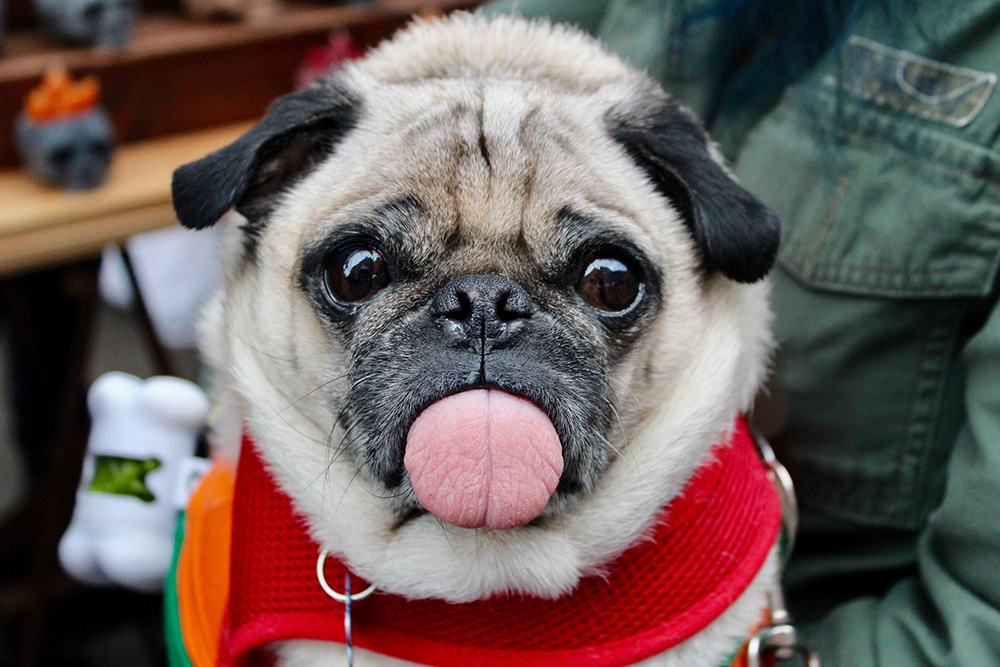This is a really common sentence we hear in consultations… and many cat owners have the same complaint! Or sometimes, when we are examining the pet in a routine consultation, we might ask if owners have ever noticed their pet has bad breath. They usually agree but have assumed that it is normal for dogs and cats to have bad breath.
Well, it actually isn’t. Bad breath (or halitosis, as it is more ‘correctly’ called) is a sign of disease. Usually the disease is located in the mouth itself, although occasionally bad breath can indicate there is something going on elsewhere in the body. However, in most of our pets, it means that there is gum (or gingival) disease. And gum disease is treatable. And once we have treated it, we can take steps to prevent it coming back.
It is staggering to realise that over 80% of dogs over 3 years old have some degree of dental disease, usually gum disease! In cats, it is a similar picture, although gum disease is just one part of the problem. Disease of the tooth itself is also common in cats. Some breeds of cats and dogs are more prone to dental problems than others but dental disease can be managed.
So, how do our pets get gum disease (periodontitis)? Usually, our young dogs and cats start off with a full set of pearly whites and the only time their breath is less than perfect is when they have eaten something particularly disgusting. (What is it about cat droppings that dogs just crave??!) Over time, bacteria that live in the mouth combined with food scraps to produce plaque, an invisible product that is coats the teeth especially up near the gums. Some of this gets removed by the tongue and chewing but, if left on the teeth, it will harden into tartar (or calculus), a creamy, brown substance that builds up over time. This causes the gums to become infected (gingivitis) and gradually they will loosen their hold on the teeth as they recede. Eventually the teeth roots become visible. Once this stage is reached the teeth usually have to be pulled out due to being unstable or developing infections in the root socket.
The only way to properly remove tartar is to scale and polish the teeth. The dental scaling equipment at our practice is designed to safely remove tartar both above and below the gum line without damaging the teeth underneath. So that our veterinarians can do the procedure safely and properly, your pet will be anaesthetised, with our usual full surgical monitoring and intravenous fluids being provided. If required, we can even take specialised dental xrays to make sure there is no underlying root disease that otherwise can be easily missed. This is particularly important in cats as nearly half of cats with dental problems get a painful condition affecting their tooth roots.
Once the tartar has been removed from your pet’s mouth, then there are a number of ways to help prevent it coming back
1. Brushing your dog’s or cat’s teeth. I know this sounds weird! But it really does work and is the best thing we can do to keep our pets mouths healthy. If done once a day, brushing does decrease the amount of dental plaque in the mouth. There are some good YouTube videos out there to demonstrate a few different methods. My favorite one is where the cat actually reminds his owner to do it and grabs the tooth brush with his paws to try to put it back in his mouth! Click here to watch it. There is also a good dog video, which shows how to introduce the whole brushing idea to your dog – watch it here.
2. Dental food. There are quite a few canines and felines out there who would make the bravest of us think twice before venturing to put a toothbrush or finger in their mouth on a regular basis! And even for those who do brush their pets’ teeth, dental food is a great back up in dental preventative health. The best dental foods help clean the teeth and discourage plaque build up using both physical and chemical methods. We provide a few of the better brands at our clinic.
3. Regular dental checks. Visiting one of our vets every 6 months allows us to pick up any problems with your pet’s mouth early so we can treat before permanent damage is done.
4. Other measures. There are also several types of good treats, dental washes, etc around to help maintain a healthy mouth. Our staff are well trained to help you find the best ways to manage your pet’s dental health.
My blog is timed to coincide with national pet dental month. During the month of August, many veterinary clinics will offer free dental checks with a veterinary nurse. We will also offer this service but extend it to all year round free dental checks with a veterinary nurse. Email us on info@southvalleyvet.com.au or call us on 03 5244 4202 to book your check with one of our nurses and receive a free Greenie dental treat for your dog or cat.






